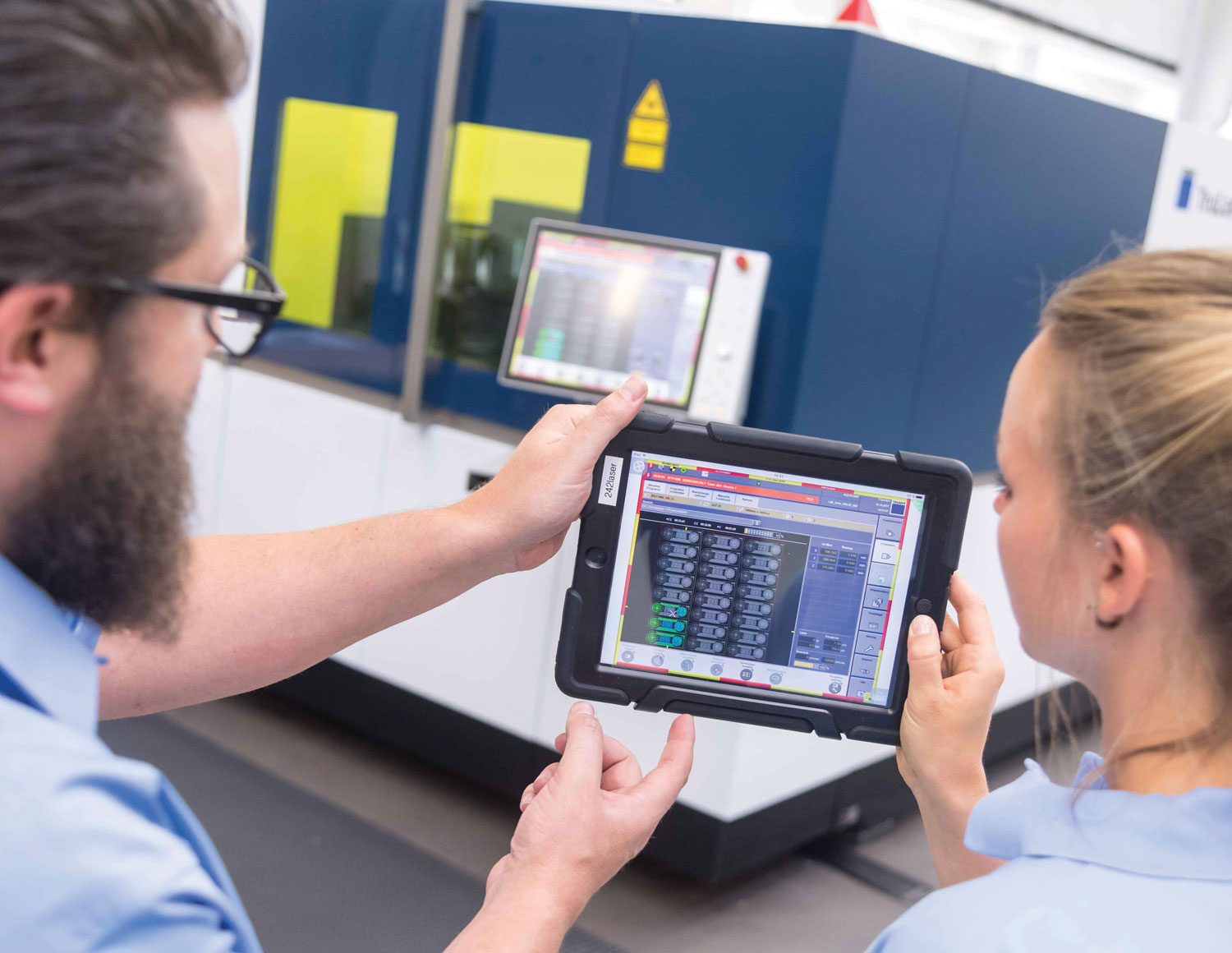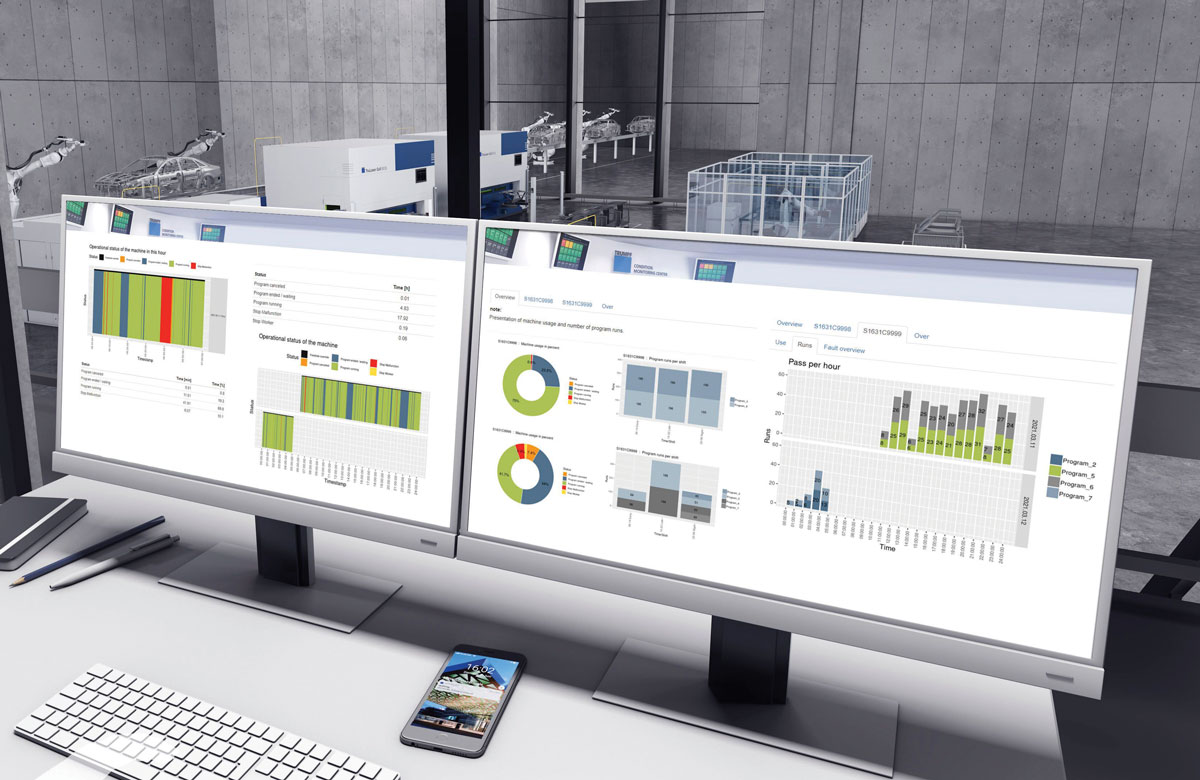
upply chain challenges and the resulting chaos are dominating the news—containers, shipping, ports, trucks, railroads, warehouses and worker shortages. According to a tally from Bank of America, supply chain glitches have been the talk of the latest company earnings season, with mentions of the issues by chief executives jumping 412 percent from last year.
As a result of the limited access to components and materials, a lot of companies are “starting to question the viability of on-demand production with the global supply chain,” says Brett Thompson, TruLaser technology and sales consultancy manager for TRUMPF Inc., Farmington, Connecticut. “There’s a lot of interest in reshoring work that’s been done overseas and, with that, comes the burden of greater labor costs. So companies are striving to make processes as efficient as possible. That’s where total shop floor transparency and data become very important.”
Data keeps things moving in a manufacturing operation. Machines use sensors and codes to provide live figures on key processes like capacity utilization, production quantities and machine status. These insights can provide owners and operators with a transparent look at their output and efficiency. With an MES (manufacturing execution system), like TRUMPF’s TruTops Fab, companies can review factors such as the run time, availability of the machine and errors that need to be recorded. “When they’re trying to quote jobs accurately and understand the cost of production, this data is extremely beneficial,” Thompson says.


Automatic data tracking on machinery has allowed TRUMPF Inc. to offer a proprietary program called Power by the Hour, which allows customers to purchase a TruLaser Series 1000/3000 machine at a lower power rating level and have on-demand access to increased power at any time for a per-minute fee.
In other words, a company might purchase a TruLaser 3030 machine with Power by the Hour, and have a 10-kilowatt laser source delivered but they’re paying for 6 kilowatts. “If they source a job that warrants the 10-kilowatt laser source, we charge them by the minute for the higher laser power,” explains Brett Thompson, TRUMPF’s TruLaser technology and sales consultancy manager. “If they eventually need that higher laser power on a regular basis, they don’t have to buy a whole new laser. It’s been a really popular program,” he says.
Paying over time for the higher power decreases the initial capital investment for the equipment, making it more accessible to smaller shops. “The flexibility is beneficial beyond that,” says Thompson, circling back to the idea of shop floor transparency. “By running calculations in TruTops Calculate, companies can look at a job and run scenarios where they use the lower laser power and the higher laser power. If they’re doing small parts, the laser won’t ever get up to its full feed rate, so the difference between 1,500 inches per minute and 2,000 inches per minute is moot.”
At that point, there’s no reason to run the higher laser power, and the parts can be run more competitively and more profitably at a lower kilowatt.
“There’s a lot of data also being extracted from a servicing perspective,” he continues. “TRUMPF has IoT capabilities within the laser source itself, with TruControl. The laser isn’t just turning on the laser beam and sending it on the cutting process, it’s collecting data that can be used for diagnostics.” A possible example of this in action would be a customer whose laser is logging a lot of collisions. “We can proactively call them and see what’s going on. We use this information partially to be able to complete remote diagnostics and remote repairs, but it also allows us to predict failures and improve our customer service.”
 The only way to compete in a global marketplace is by making the equipment as intelligent as it can be.
The only way to compete in a global marketplace is by making the equipment as intelligent as it can be. 
Thompson says these data collection and diagnostic alerts benefited a customer who was cutting expanded metal. “They had more gaps than actual material, which had to pass the sensors on the cutting unit. We were getting a lot of collision warnings in our service department, so we gave this customer a call.”
As it was being cut, the expanded metal was occasionally dipping down into the work table’s slats, which was causing these collisions. The fix was easy: “Turn off capacitive sensing,” says Thompson. This customer has since achieved better throughput times because they’re not constantly having the cutting unit collide, but they’re also going through fewer nozzles and other parts.
A smoothly connected flow from material to machines and automation through to suppliers and customers is the ultimate goal for an intelligent factory. But “there’s obviously a cost to having a big MES system tied into all this equipment,” Thompson says. Smaller job shops, for example, don’t have to choose between making the leap to MES or foregoing the advantages provided by connectivity and transparency. Instead, they can benefit on a smaller scale from software like TruTops Monitor, according to Thompson.
“It gives them the ability to look into the actual programs on the TRUMPF machines, and they’re able to monitor what’s going on in real time,” he points out. “We might not be communicating with an MES, or third-party software system, but the customer still has transparency. For example, they can see that they’re quoting the job at one hour and it’s taking one hour and 15 minutes—and then they can review the data and figure out why that’s happening.”
The next frontier for data will build upon machine learning, Thompson says, citing TRUMPF’s Active Speed Control as an indicator of this trend. Active Speed Control (ASC) monitors the kerf through the nozzle, oversees the cutting process and independently regulates feed speed.
“[ASC is] capable of actually looking at the cut and predicting whether it can speed up or whether it should slow down based on the conditions. Ideally, this will continue to expand, controlling the gas, pressure, focus position. The idea would be to get the ideal parameters—load up a piece of material, let the laser sample it and adapt completely on its own,” he says. “The only way we’re going to be able to compete in a global marketplace against low-cost labor markets is by making the equipment as intelligent as it can be.”